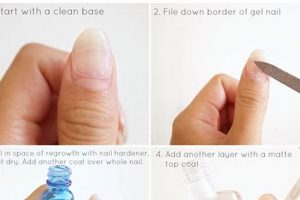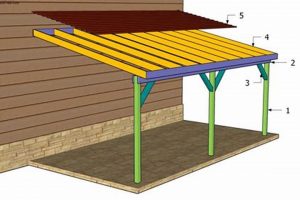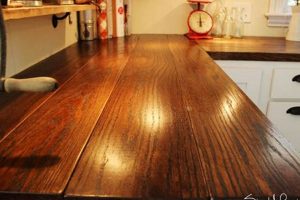The application of a ceramic-based finish, commonly known for its durability and protective qualities, can be undertaken by individuals in a non-professional setting. This method allows for the customization and protection of various items, typically firearms and automotive parts, outside of a specialized industrial environment. This type of coating offers resistance to abrasion, corrosion, and impact, extending the lifespan and enhancing the aesthetic appeal of treated objects.
Implementing this coating oneself presents several advantages, including cost savings compared to professional services and the potential for a personalized finish. It grants enthusiasts direct control over the application process and allows for convenient project completion in a home workshop. Historically, such coatings were primarily applied in manufacturing settings; however, advances in application methods and readily available materials have enabled broader accessibility for individual users. The benefits also encompass increased satisfaction derived from completing a hands-on project and the acquisition of a new skill.
The following sections will address the essential steps involved in achieving a successful coating, detailing necessary equipment, preparation techniques, application methods, and post-application procedures. Furthermore, it will discuss potential challenges and provide safety guidelines for those interested in pursuing this type of project.
Essential Considerations for Ceramic Coating at Home
Achieving a professional-grade ceramic coating finish requires diligent attention to detail and adherence to best practices. The following tips outline crucial considerations for ensuring optimal results and long-term performance.
Tip 1: Thorough Surface Preparation: Proper surface preparation is paramount. Degrease and abrasive blast all items to be coated to create an ideal surface profile for maximum adhesion. Contamination will compromise the coatings integrity and longevity.
Tip 2: Precise Mixing Ratios: Adherence to the manufacturer’s specified mixing ratios is critical. Deviations can alter the coating’s chemical properties, resulting in inconsistencies in color, durability, and overall performance. Utilize calibrated measuring tools to ensure accuracy.
Tip 3: Consistent Application Technique: Employ a consistent spray technique, maintaining a uniform distance and speed to achieve an even coating thickness. Overlapping passes are preferable to avoid runs or thin spots. Practice on scrap material to refine technique.
Tip 4: Environmental Control: Maintain a controlled environment during the application and curing processes. Consistent temperature and humidity levels are essential for proper cross-linking and adhesion. Avoid areas prone to drafts or airborne contaminants.
Tip 5: Adequate Curing Process: Follow the manufacturer’s recommended curing schedule precisely. Ensure that the coated items reach the prescribed temperature for the specified duration to achieve full hardness and chemical resistance. Verify oven temperature accuracy with a separate thermometer.
Tip 6: Wear Appropriate Safety Gear: This process involves potentially harmful chemicals. Always wear a respirator, gloves, and eye protection when spraying. Ensure adequate ventilation in the workspace to minimize exposure to fumes.
Consistent application of these tips will contribute significantly to a successful and durable ceramic coating. By focusing on preparation, precision, and environmental control, superior results can be achieved.
Following these guidelines will lay a foundation for a durable and aesthetically pleasing finish. The subsequent article sections will delve into more complex aspects of the ceramic coating process.
1. Surface Preparation
Surface preparation forms the critical foundation for any successful ceramic coating, particularly when undertaken outside of a professional setting. The effectiveness and longevity of the coating are directly proportional to the quality of the surface preparation. Inadequate preparation can lead to coating failures such as peeling, chipping, or corrosion, thereby negating the intended protective or aesthetic benefits. The process typically involves degreasing the substrate to remove oils and contaminants, followed by abrasive blasting to create a textured surface for optimal adhesion. For instance, consider coating firearm components; residual oils or imperfections left on the metal will prevent the ceramic from properly bonding, resulting in premature wear and potential functional issues.
Different substrates require specific preparation techniques. Aluminum, for example, might necessitate a different abrasive media compared to steel to achieve the desired surface profile without causing excessive material removal. Proper masking of areas that should not be coated is also crucial during this stage. A real-world example could be coating motorcycle exhaust components; failing to adequately mask mating surfaces could prevent proper assembly post-coating. Furthermore, thorough cleaning after abrasive blasting is essential to remove any residual abrasive particles, ensuring a contaminant-free surface for coating application. The investment of time and resources in thorough surface preparation directly translates to an extended lifespan and superior performance of the final ceramic-coated product.
In summary, the significance of surface preparation in the ceramic coating process cannot be overstated, and the success of the project is determined largely by the efficacy of this initial phase. Challenges such as selecting the correct abrasive media and achieving a uniform surface profile can be overcome with careful research and practice. The principles of surface preparation are universally applicable to various applications, solidifying its role as an indispensable component of achieving professional-grade results in a non-professional environment.
2. Equipment Acquisition
Successful ceramic coating application outside a professional environment necessitates strategic equipment acquisition. The selection and procurement of appropriate tools directly impact the quality and durability of the finished product. The absence of essential equipment or the use of substandard tools can lead to application errors, inconsistent coating thickness, and ultimately, premature coating failure. For example, using an inadequate air compressor may result in inconsistent spray patterns, causing uneven coverage and potential blemishes. Conversely, investing in a high-quality HVLP (High Volume Low Pressure) spray gun, specifically designed for ceramic coatings, can provide greater control and atomization, leading to a smoother and more uniform finish. The cost of acquiring necessary equipment, including a calibrated oven, abrasive blaster, and personal protective equipment, represents a significant initial investment b
ut is vital for achieving professional-level results.
The implications of equipment acquisition extend beyond the application stage and into the curing process. A precisely controlled oven is crucial for achieving the optimal hardness and chemical resistance of the ceramic coating. A standard kitchen oven lacks the temperature consistency and control required, potentially leading to under-cured or over-cured finishes that compromise the coating’s protective properties. An example of the practical significance of this point is the coating of firearm components. Substandard curing can lead to a coating that is insufficiently resistant to solvents and wear, resulting in compromised firearm performance and longevity. Furthermore, equipment acquisition includes ensuring adequate ventilation and safety measures, highlighting the responsibility to provide a safe and controlled workspace, where the safety of the individual using the equipment is guaranteed by proper equipment, not compromised by using inadequate less safe equipment.
In summary, the acquisition of proper equipment is not merely a logistical consideration but an integral factor determining the success of non-professional ceramic coating endeavors. The trade-off between initial investment and long-term quality necessitates careful evaluation and prioritization. Selecting suitable equipment is a critical decision in the scope of a ceramic project. The correlation between appropriate equipment and the quality of the final coating underscores the importance of informed decision-making in this process. Therefore, equipment acquisition can be summarized by, do not go cheap on critical tools and be sure to maintain and use them properly to produce quality parts.
3. Application Technique
Application technique is pivotal in the successful execution of ceramic coating projects conducted outside professional facilities. The quality of the finish, the durability of the coating, and the overall protective properties are directly influenced by the application method employed. An improper technique can lead to a range of undesirable outcomes, including runs, sags, orange peel texture, and inconsistent coating thickness. For instance, if the spray gun is held too close to the substrate, excessive material buildup occurs, resulting in sags and potentially compromising the coating’s structural integrity. Conversely, holding the gun too far away can lead to a dry, textured finish that lacks proper adhesion. These scenarios highlight the cause-and-effect relationship between application technique and the final result of a ceramic coating applied in a non-professional setting.
The significance of proper application lies not only in achieving an aesthetically pleasing finish but also in ensuring the coating fulfills its intended protective function. Uneven coating thickness, for example, can create vulnerable points where corrosion or abrasion resistance is compromised. Consider the application to firearm components; a thin coating on critical wear surfaces will lead to premature failure and diminished firearm lifespan. Proper application necessitates mastering spray gun settings, understanding material flow rates, and maintaining consistent distance and angle relative to the substrate. The importance of layering, and proper flash times cannot be ignored, as they can cause a multitude of issues.
In summary, mastering the application technique is a cornerstone of non-professional ceramic coating endeavors. It requires meticulous attention to detail, consistent practice, and a thorough understanding of the materials and equipment involved. While challenges such as achieving uniform coating thickness and preventing common application defects exist, they can be overcome with dedicated practice and adherence to best practices. The correlation between skilled application technique and a durable, aesthetically pleasing finish underscores its importance in the broader context of ceramic coating projects undertaken in non-industrial environments. Correct application technique creates a higher margin of error in the quality of the cerakote finish.
4. Curing Process
The curing process represents a critical stage in the application of ceramic coatings, particularly in the context of non-professional, or “diy cerakote” endeavors. It dictates the final hardness, chemical resistance, and overall durability of the coating. The curing process, typically involving elevated temperatures applied for a specified duration, facilitates the cross-linking of polymer chains within the coating matrix, resulting in a hardened, robust finish. Inadequate curing, whether due to insufficient temperature or duration, compromises these properties, leaving the coating susceptible to scratching, chipping, and chemical degradation. For example, if a firearm receiver is coated and not cured according to the manufacturers specifications, the resulting finish might not withstand the solvents used in routine firearm maintenance, leading to premature wear and corrosion. The curing process, therefore, is not merely a finishing step, but an integral component of the coatings fundamental performance characteristics.
Practical application demands precise adherence to recommended curing schedules. Deviations can have tangible consequences, influencing the longevity and functionality of the coated object. Consider automotive components subjected to high-temperature environments, such as exhaust manifolds. If the coating is not properly cured, its heat resistance will be compromised, leading to discoloration, cracking, and eventual failure. Precise temperature control, often achieved through calibrated ovens, is paramount. Furthermore, factors such as ambient humidity and air circulation within the curing chamber can influence the curing rate and uniformity of the finish. Documenting and meticulously following manufacturer guidelines and recommendations, including preheating and maintaining the desired internal temperature of the part being coated, is vital for ensuring optimal curing results.
In summary, the curing process exerts a definitive influence on the properties of ceramic coatings applied in non-professional settings. Proper adherence to recommended procedures and precise control over environmental factors are essential for achieving a durable, high-performance finish. Challenges such as temperature calibration and ensuring consistent heat distribution within the curing chamber require careful attention and investment in suitable equipment. Understanding and effectively managing the curing process is thus a key determinant of success in “diy cerakote” projects, linking directly to the final quality and long-term performance of the coated item.
5. Safety Protocols
The application of ceramic coatings outside of professional facilities inherently introduces potential hazards. Adherence to stringent safety protocols is not merely a recommendation but a fundamental requirement for protecting the applicator and preventing accidents. The use of specialized chemicals, equipment, and processes necessitates a thorough understanding of potential risks and the implementation of effective preventative measures.
- Respiratory Protection
The spraying of ceramic coatings generates airborne particula
tes and volatile organic compounds (VOCs). Inhalation of these substances can cause respiratory irritation, sensitization, and potential long-term health effects. Proper respiratory protection, including the use of NIOSH-approved respirators with appropriate cartridges for organic vapors and particulate matter, is essential. The respirator must be properly fitted and maintained to ensure an adequate seal. Failure to use appropriate respiratory protection exposes the applicator to significant health risks. - Ventilation
Adequate ventilation is crucial for removing airborne contaminants generated during the coating process. Spraying should be conducted in a well-ventilated area, preferably a designated spray booth with a functioning exhaust system. Insufficient ventilation allows for the accumulation of hazardous fumes, increasing the risk of inhalation exposure and potentially creating a fire or explosion hazard. Cross-ventilation can significantly reduce the concentration of airborne contaminants, improving air quality and minimizing health risks.
- Personal Protective Equipment (PPE)
In addition to respiratory protection, other forms of PPE are necessary to protect the skin and eyes from chemical exposure. Chemical-resistant gloves, such as nitrile or neoprene, should be worn to prevent skin contact with coating materials and solvents. Eye protection, including safety glasses or a face shield, is necessary to prevent splashes or airborne particles from entering the eyes. Long sleeves and pants are also recommended to minimize skin exposure.
- Fire Safety
Many ceramic coating materials and solvents are flammable. Precautions must be taken to prevent fire hazards, including eliminating sources of ignition, such as open flames, sparks, and static electricity. Flammable materials should be stored in approved containers in a well-ventilated area away from heat sources. A fire extinguisher suitable for chemical fires should be readily accessible. Proper grounding of equipment can also help prevent static electricity buildup and reduce the risk of ignition.
The integration of these safety protocols is paramount for mitigating risks associated with “diy cerakote” applications. Neglecting any aspect of safety can have severe consequences, ranging from acute health effects to catastrophic accidents. Diligent adherence to established safety guidelines is the responsibility of anyone undertaking ceramic coating projects outside a professional setting.
6. Material Properties
The selection of appropriate coating materials is paramount for the success of ceramic coating projects undertaken outside professional settings. Understanding the inherent material properties of different ceramic coatings dictates their suitability for specific applications and directly influences the longevity and performance of the finished product. A misinformed choice regarding material properties can lead to premature coating failure, diminished protective capabilities, and compromised aesthetic outcomes.
- Hardness and Abrasion Resistance
Hardness, measured on scales such as Vickers or Rockwell, indicates a material’s resistance to indentation. Abrasion resistance, closely related, describes the coating’s ability to withstand wear from friction. For firearm components subject to repetitive motion and contact, coatings with high hardness and abrasion resistance are crucial. For example, a slide coated with a material lacking sufficient hardness will exhibit accelerated wear, potentially impacting functionality and requiring frequent re-coating. The choice of a coating with appropriate properties ensures longevity and maintained performance.
- Corrosion Resistance
Corrosion resistance is critical for objects exposed to environmental elements or corrosive substances. Ceramic coatings formulated with specific additives provide a barrier against moisture, salts, and acids, preventing oxidation and degradation of the underlying substrate. Marine applications, such as coating boat hardware, demand coatings with exceptional corrosion resistance to withstand saltwater exposure. Selecting a coating with inadequate corrosion resistance in such an environment would lead to rapid deterioration and compromised structural integrity.
- Chemical Resistance
Chemical resistance refers to a coating’s ability to withstand exposure to various chemicals without degradation. This property is particularly important for applications involving frequent contact with solvents, oils, or cleaning agents. Automotive components, for instance, often encounter gasoline, brake fluid, and degreasers. A coating with poor chemical resistance will swell, soften, or dissolve upon exposure, compromising its protective function. The correct material choice preserves the coating’s integrity and prolongs its lifespan.
- Thermal Stability
Thermal stability describes a coating’s ability to maintain its properties at elevated temperatures. Certain applications, such as coating exhaust components or engine parts, require coatings that can withstand extreme heat without cracking, blistering, or delaminating. Coatings with low thermal stability will degrade under high-temperature conditions, losing their protective and aesthetic qualities. The selection of a thermally stable coating ensures long-term performance in high-heat environments.
The interplay of these material properties underscores the necessity for informed decision-making in “diy cerakote” projects. Careful consideration of the intended application and the environmental conditions to which the coated object will be exposed is essential for selecting a coating material that provides optimal performance and durability. Success in non-professional ceramic coating depends on a comprehensive understanding of material properties and their influence on the final outcome.
Frequently Asked Questions Regarding Ceramic Coating
The following section addresses common inquiries and misconceptions surrounding ceramic coating application, specifically within non-professional environments. These answers are intended to provide clarity and guidance for individuals considering undertaking such projects.
Question 1: Is specialized equipment absolutely necessary for performing a coating application?
While certain “hacks” may be possible with the use of rattle-cans, for a finish that will last it is a resounding yes. Achieving a durable, consistent, and professional-grade coating necessitates the use of specific equipment. This includes an abrasive blasting unit, a calibrated spray gun, a temperature-controlled oven, and appropriate safety gear. Substituting these tools with makeshift alternatives will likely result in a compromised finish and reduced coating lifespan.
Question 2: Can any type of oven be used for curing ceramic coatings?
No. A standard kitchen oven is unsuitable for curing ceramic coatings due to a lack of precise temperature control and the potential for uneven heat distribution. A dedicated curing oven with accurate temperature regulation is essential to ensure proper cross-linking of the coating material, resulting in optimal hardness and chemical resistance.
Question 3: How critical is surface preparation prior to coating application?
Surface preparation is paramount to the success of any ceramic coating project. Thorough degreasing and abrasive blasting are essential for removing contaminants and creating a surface profile that pro
motes optimal coating adhesion. Failure to properly prepare the surface will likely result in coating failures such as peeling, chipping, or corrosion.
Question 4: What safety precautions are necessary when working with ceramic coatings?
The application of ceramic coatings involves the use of potentially hazardous materials. Proper safety precautions, including the use of a NIOSH-approved respirator, chemical-resistant gloves, and eye protection, are essential for minimizing exposure to airborne particulates and volatile organic compounds. Adequate ventilation is also crucial for maintaining a safe working environment.
Question 5: Is it possible to achieve the same results as a professional coating facility?
While skilled individuals can achieve commendable results through a do-it-yourself approach, replicating the consistent quality and precision of a professional coating facility can be challenging. Professional facilities possess specialized equipment, controlled environments, and experienced technicians who have honed their skills through extensive practice. Achieving comparable results requires significant dedication, attention to detail, and a willingness to invest in appropriate equipment and training.
Question 6: How should the finished surface be cleaned and maintained?
Cleaning and maintenance protocols vary depending on the specific coating material and application. However, in general, the use of harsh chemicals or abrasive cleaners should be avoided. Mild detergents and soft cloths are typically recommended for cleaning coated surfaces. Regular cleaning helps to remove contaminants and maintain the aesthetic appearance of the finish.
In conclusion, the successful application of ceramic coatings in non-professional environments hinges on adherence to established best practices, meticulous attention to detail, and a commitment to safety. Informed decision-making and a willingness to invest in appropriate equipment and training are essential for achieving satisfactory results.
The following section will explore the troubleshooting of common issues encountered during the ceramic coating process.
Conclusion
“Diy cerakote”, as explored in this article, presents both opportunities and challenges for individuals seeking to apply ceramic coatings outside of professional facilities. The success of such endeavors hinges on a comprehensive understanding of material properties, meticulous attention to surface preparation, proper application techniques, adherence to safety protocols, and a commitment to investing in suitable equipment. The quality of the final product is directly proportional to the level of diligence and expertise applied throughout the entire process.
The information presented here serves as a foundational resource for those considering undertaking “diy cerakote” projects. While the allure of cost savings and customization is undeniable, prospective applicators must carefully weigh the potential risks and complexities involved. Armed with the knowledge and resources outlined, individuals can make informed decisions and approach ceramic coating applications with a higher likelihood of achieving durable, aesthetically pleasing, and functionally sound results.







